Structure of Atom
Get insights from 126 questions on Structure of Atom, answered by students, alumni, and experts. You may also ask and answer any question you like about Structure of Atom
Follow Ask QuestionQuestions
Discussions
Active Users
Followers
New answer posted
3 months agoContributor-Level 10
Bohr's model solved the instability problem by proving about stationary states. In such stats, the electrons move in fixed orbits. They do not emit energy. This contradicted classical electromagnetic theory of Maxwell, which says accelerating charges should emit radiation and collapse into the nucleus. Bohr simply assumed Maxwell's laws don't apply to these special orbits.
New answer posted
3 months agoContributor-Level 10
Bohr's model is too simple for atoms beyond hydrogen. In multi-electron atoms like helium, it fails because it ignores a couple of aspects. First is the electron-to-electron repulsion, and second is the shielding effect, where inner electrons reduce the nuclear pull on outer ones. Due to both, orbitals with the same principal quantum number don't have the same energy. Bohr's model of atom assumes that it should have the same energy.
New answer posted
4 months agoContributor-Level 10
Correctly identifying isotopes and isobars requires knowing both the atomic and mass numbers. Relying on only one is a common error.
- Isotopes: Same element (atomic number), different mass.
- Isobars: Different elements (atomic number), same mass.
New answer posted
4 months agoContributor-Level 10
Rutherford's atomic model was a breakthrough, but it was flawed. It couldn't explain atomic stability, as orbiting electrons should lose energy and spiral into the nucleus. It also failed to account for the discrete line spectra observed from excited atoms.
New answer posted
4 months agoNew question posted
4 months agoNew answer posted
4 months agoContributor-Level 10
= 0.03 * 10-17 = 3.0 * 10-19 J/atom
= 18.06 * 101 kJ/mole = 180.6
New answer posted
4 months agoContributor-Level 10
The early 20th century experiments on electrical discharge through gases eventually led to the discovery of cathode rays (electrons). The major finding was that the characteristics of these cathode rays (electrons) were independent of the material used for the electrodes and the nature of the gas present in the cathode ray tube. This consistent behaviour across different substances led to the conclusion that electrons are a basic constituent of all atoms.
Taking an Exam? Selecting a College?
Get authentic answers from experts, students and alumni that you won't find anywhere else
Sign Up on ShikshaOn Shiksha, get access to
- 66k Colleges
- 1.2k Exams
- 680k Reviews
- 1800k Answers


